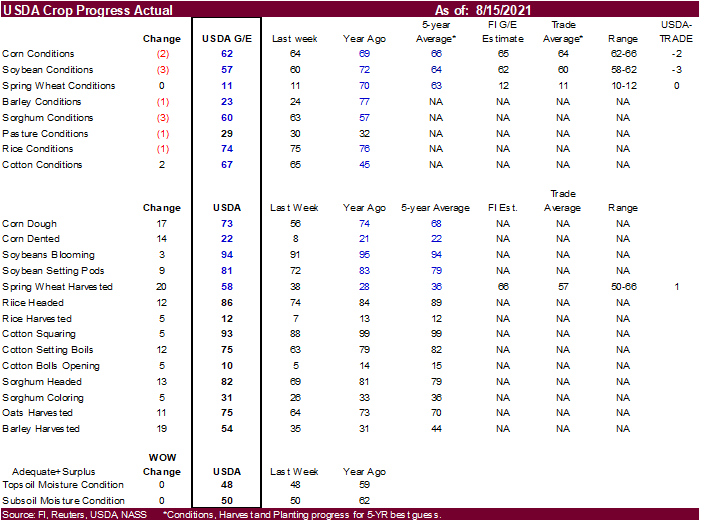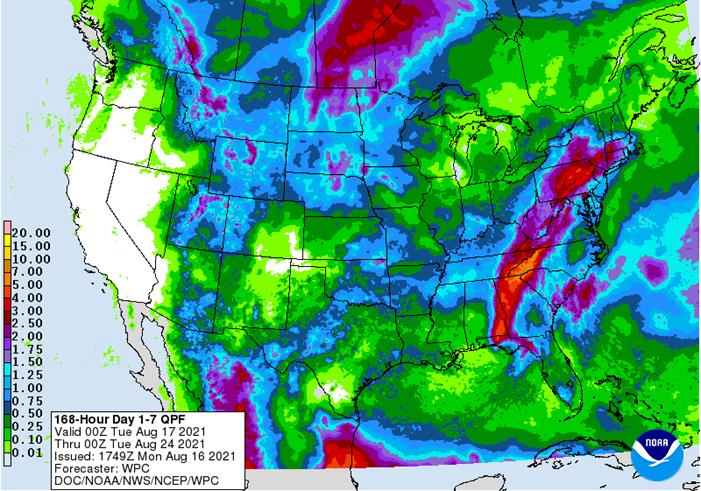PDF Attached
WASHINGTON,
Aug 16, 2021- Private exporters reported to the U.S. Department of Agriculture export sales of 132,000 metric tons of soybeans for delivery to unknown destinations during the 2021/2022 marketing year.
US
corn crop conditions declined 2 points to 62% and soybean dropped 3 points to 57%. Spring wheat was unchanged at 11%. Spring wheat harvest 58%, up from 38% last week.
Calls:
Soybeans up 5-9, corn up 4-6, spring wheat unchanged to 3 higher. Chicago wheat unchanged/higher. KC mixed. Pro Farmer crop tour started today.
Ohio
and South Dakota averages should be out later this afternoon. Twitter feed #PFCropTour21

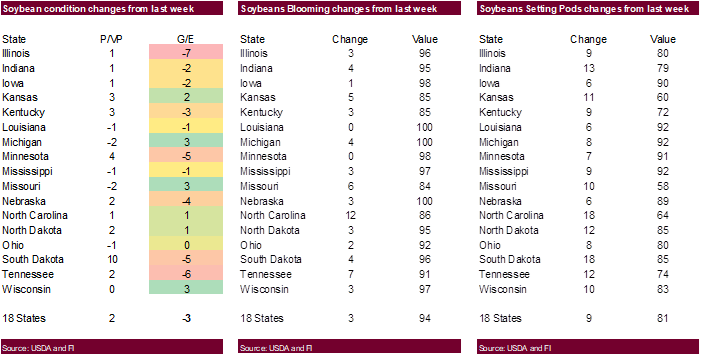
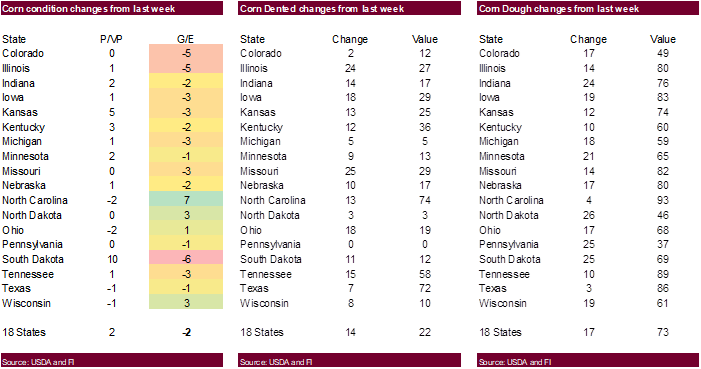
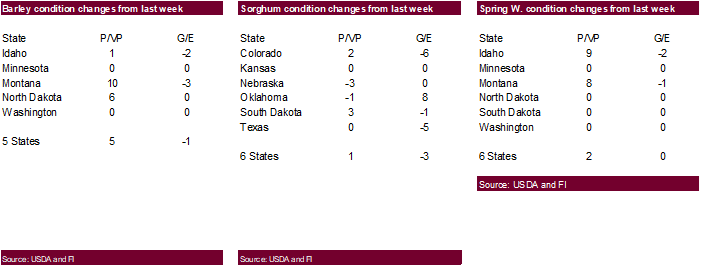
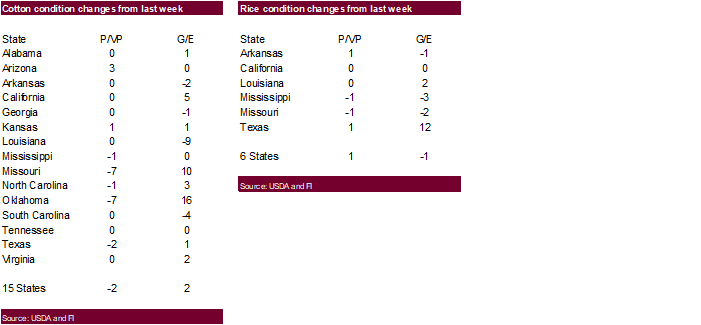
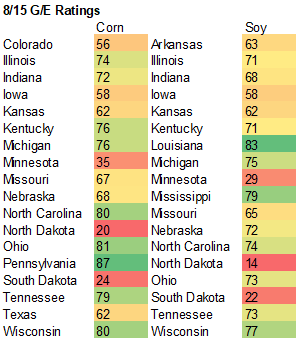
Weather
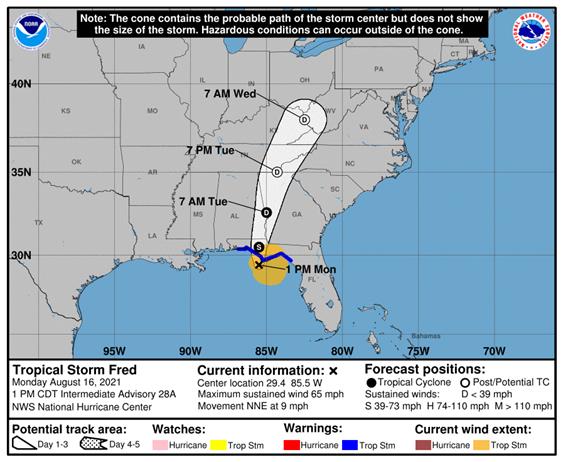
WORLD
WEATHER INC.
MOST
IMPORTANT WEATHER OF THE DAY
- Tropical
Storm Fred will reach areas east of Destin, Florida this evening and will produce 3.00 to 6.00 inches of rain from that area north northeast into east-central Alabama and immediate neighboring areas of west-central Georgia through Tuesday
o
Rainfall farther north in northern Georgia and the Appalachian Mountains will range from 1.50 to 4.00 inches
o
Flooding is most likely near the coast in Florida and in a few areas of southeastern Alabama
o
Crop damage is expected to be minimal
o
Property damage is possible near the Florida coast
- Tropical
Depression Grace will produce 4.00 to 12.00 inches of rain in southern parts of Hispaniola today and Tuesday while the north half of the island receives less than 4.00 inches with some areas getting only 0.50 inch
o
No wind damage is expected
o
Flooding near the south coast may cause some damage to crops and urban areas
- Tropical
Depression Grace will become a tropical storm as it moves between Jamaica and Cuba late Tuesday into Wednesday and then will move to the northeastern Yucatan Peninsula of Mexico late this week
o
The storm could still become a hurricane and should be watched
o
Ultimate landfall may be in northeastern Mexico and/or in far southern Texas during the weekend
- Tropical
Depression Eight is expected to become a tropical storm today while it loops around Bermuda. The system is unlikely to be a threat to the island or North America.
- Hurricane
Linda in the eastern Pacific Ocean poses no threat to North America - West
Texas rainfall during the weekend was a little greater than expected in some areas
o
Rain amounts varied from nothing to 2.26 inches (4 miles southeast of Lubbock) with about one-third to one-half of the region reporting 0.30 to 0.80 inch with many 1.00 to 1.50-inch amounts in the north
- Driest
in the south and east parts of the region - U.S.
weekend precipitation was greatest from Texas through the Delta to the southeastern states
o
The precipitation was scattered and highly varied, but some locations reported 1.00 to more than 2.00 inches while others were left dry
o
Good harvest weather continued in South Texas with a couple of exceptions
o
Temperatures were hot in the far western and north-central states and quite warm in the south from central Texas and Oklahoma to the middle southern Atlantic Coast States
o
Midwest temperatures were seasonable
- Strong
Gulf of Mexico moisture flux into central U.S. could set the stage for greater rain in northern U.S. Plains, Canada’s Prairies late this week
o
However, Tropical Depression Grace could interfere with this moisture flux which leaves the potential for significant rain still up for big debate
- Some
rain is expected, but the mid-day GFS model run was likely too wet in Saskatchewan and possibly in parts of the Plains and western Corn Belt - The
evening GFS model run (18z) has shifted the greatest rain into extreme eastern Saskatchewan and northern and western Manitoba and this too is debatable - The
model run is likely too wet in these areas - Some
rain and strong wind will impact a part of the northern U.S. Plains and Canada’s Prairies during mid-week this week. However, the drought will not be over
o
Manitoba, southwestern Alberta and a few areas near the southwest Saskatchewan/southeastern Alberta border area will be wettest
o
Corn, soybeans and flax in Manitoba may be the greatest recipient of rain and crops may improve further after getting some significant rain last week
- Most
likely the advertised rain by the European model run today is overdone and some of the rain on the GFS model is probably a little high as well - 0.50
to 1.50 inches and locally more is possible, but confidence is low - U.S.
Midwest, Delta and central and southern U.S. Plains will experience a good mix of weather during the next ten days with sufficient rain to limit the expansion of dryness into the key Corn and Soybean Belt production areas
o
Rainfall will vary widely with some areas getting enough to maintain favorable crop development, a few trending a little wetter and a few others drying down
- No
aggressive dry down is expected; however, the most limited rainfall this week will be in the Great Lakes region and the middle and upper Mississippi River Valley - Some
rain may come to this crop region next week and it will be important after this week’s drying trend
o
Temperatures will be seasonable with a warmer than usual bias in the northern Plains and portions of the Rocky Mountain region, Great Basin and far western states
- U.S.
southeastern states will be trending wetter this week because of remnants of Tropical Storm Fred and a mid-latitude frontal system that will produce near to above normal rainfall except in southwestern Alabama and southeastern Mississippi where rainfall may
be less than usual
o
Florida’s Peninsula is also expecting less than usual rainfall
- Northeast
Mexico could benefit greatly from rain if Tropical Depression Grace decides to move into that region.
o
The area has been drought-stricken for a few years and needs rain to change the outlook for 2022
- Western
and southern Mexico crop conditions remain favorable due to well-timed rainfall, although Baja California and some immediate mainland coastal areas need rain - Excessive
heat occurred in Spain and some of the islands in the western Mediterranean Sea during the weekend with highs of 100 to 113 occurring in central and interior southern Spain and southern Portugal
o
Cordoba, Spain reported an extreme of 116.6 Fahrenheit
o
A few extreme highs over 100 Fahrenheit also occurred in northern parts of the Italian Peninsula
o
Other areas in Europe were warm and drier than usual supporting a big improvement in winter crop harvest conditions
o
Rapid drying in the topsoil was noted, but some timely rain will fall early this week to slow the trend and follow up rain will be needed later this month
- Some
of the excessive heat in Africa and the western Mediterranean region will surge northward later this week impacting a larger part of southern Europe for several days
o
Extreme highs in the 90s to 106 degrees Fahrenheit will impact the southern half of the continent
- Cooling
and some rain will follow next week
o
Drying across the continent later this week and into the weekend will be great for harvest progress and for speeding along summer crop development
- Areas
with short to very short soil moisture will experience rising stress and that will include the Balkan Countries where it has already been dry for several weeks - Crop
yields will continue to slide lower in this region - Rain
developed from extreme eastern Ukraine and western most parts of Russia’s Southern Region into the middle Volga River Basin during the weekend
o
Resulting rainfall varied from 0.15 inch to 0.88 inch with a couple of locations reporting 2.50 to 4.60 inches
- The
heavier rainfall was extremely localized
o
Additional rain will fall in this region and in neighboring areas of Russia’s Southern Region and lower Volga River Basin early this week followed by several days of drying and then a few more showers
- Net
drying continued during the weekend and will persist into next week in many Kazakhstan and southern Russia New Lands crop areas
o
Moisture stress this year has cut into spring wheat and sunseed production and those losses have continued, although the greatest losses have already occurred
- A
good mix of shower activity and warm temperatures will occur in central and eastern Ukraine, Belarus and western and northern Russia over the next ten days to maintain most crop needs - Drying
is expected in the Ural Mountain region and southern New Lands during the next ten days speeding along spring crop maturation
o
A few late season crops may mature under stress threatening a small decline in yield or quality, but the impact should be low
- China’s
Yangtze River Basin reported pockets of locally heavy rain during the weekend with more than 8.00 inches in the lower parts of the basin and as much as 13.46 inches near the southeastern Sichuan/Hubei border
o
Rainfall elsewhere was much more erratic with parts of the Yellow River Basin and northeastern provinces experiencing net drying conditions
o
Temperatures across the nation were seasonable with a slight cooler bias in the wetter areas of the interior south
- China
will continue to see alternating periods of rain and sunshine over the next ten days with the Yellow River Basin driest and the Yangtze River Basin wettest
o
Some additional flooding may impact a part of Sichuan and the Yangtze River Basin
o
Some periodic rainfall is also expected in northeastern China that will be more than sufficient to maintain a good outlook for summer crops
o
Temperatures will be seasonable
o
Next week may be wetter again in the Yellow River Basin
- Northwestern
India is still advertised to be drier than usual over the next two weeks along with parts of Pakistan
o
Gujarat, western and northern Rajasthan and central and southern Pakistan may not get enough rain to counter evaporation
- Crop
stress will continue to rise in unirrigated fields - India
rainfall during the weekend was restricted in many areas, but much more rain is expected in central and eastern parts of the nation over the next ten days
o
Northeastern Maharashtra, Madhya Pradesh and most of the Ganges River Basin, Bangladesh and far Eastern States will be wettest with 4.00 to more than 8.00 inches expected in many areas
o
Southern India will get rain, too, but it will be lighter and more beneficial
- Needed
rain fell in eastern South Africa wheat production areas during the weekend lifting soil moisture and improving unirrigated crop conditions ahead of spring development
o
The nation’s western wheat is already well established and poised to perform well
- Now
unirrigated eastern states will experience improvement, although some additional rain is still needed - South
Africa will experience some additional rain over the next ten days with southern and easternmost parts of the nation wettest - Argentina
southern and eastern crop areas will get some rain in the second half of this week, but western crop areas are expecting to be dry biased through the next two weeks
o
Winter crops are dormant or semi-dormant right now making the moisture shortage in the west of little concern, but spring rainfall will be very important
- Brazil
rainfall will continue limited to the far south over the next two weeks which is not unusual for this time of year
o
Large moisture deficits remain in center south Brazil from 2020-2021 and could be a factor in spring crop development potential if La Nina delays the onset of season moisture
o
River and stream flow remain critically low in much of the Parana River Basin
- Southeast
Asia nations will all receive sufficient rain to support crops during the next two weeks
o
The forecast includes an improving rain distribution for Sumatra, Java, Kalimantan, Thailand and the central and southern Philippines all of which have been trending a little too dry recently
- Thailand
will be the one nation to watch for possible inadequate rainfall - East-central
Africa rainfall in this coming week will continue abundant in Ethiopia and a routine occurrence of rain will also occur in Kenya and Uganda - West
Central Africa weather will be seasonable over the next two weeks
o
Rain will continue to fall periodically over the next couple of weeks, although the lightest rainfall will be in southern Ivory Coast and Ghana
- Australia
weather will continue favorably for wheat, barley and canola which are semi-dormant at this time of year. Soil moisture is favorable and ready to support spring growth when warming comes along especially if timely rainfall continues as advertised
o
Queensland and northern New South Wales still need significant rain to restore soil moisture after recent drying
- Southern
Oscillation Index has reached +5.43 and it will continue to drift lower this week, albeit at a slower pace.
- Central
America rainfall has been plentiful and will remain that way for the next ten days - New
Zealand rainfall during the coming week will be above average while temperatures are a little cooler than usual
Source:
World Weather Inc.
Monday,
Aug. 16:
- USDA
export inspections – corn, soybeans, wheat, 11am - U.S.
crop conditions – corn, cotton, soybeans, wheat, 4pm - Ivory
Coast cocoa arrivals - HOLIDAY:
Argentina
Tuesday,
Aug. 17:
- EU
weekly grain, oilseed import and export data - New
Zealand global dairy trade auction - HOLIDAY:
Indonesia
Wednesday,
Aug. 18:
- EIA
weekly U.S. ethanol inventories, production - China’s
second batch of July trade data for commodities, including corn, wheat, sugar and pork
Thursday,
Aug. 19:
- USDA
weekly crop net-export sales for corn, soybeans, wheat, cotton, pork, beef, 8:30am - Brazil’s
Conab releases sugar and cane production data (tentative) - USDA
total milk, read meat production - Port
of Rouen data on French grain exports - HOLIDAY:
India, Pakistan, Bangladesh
Friday,
Aug. 20:
- ICE
Futures Europe weekly commitments of traders report (6:30pm London) - CFTC
commitments of traders weekly report on positions for various U.S. futures and options, 3:30pm - China’s
country-wise import data for farm goods such as soybeans, corn and pork - FranceAgriMer
weekly update on crop conditions - Malaysia
Aug. 1-20 palm oil export data - U.S.
Cattle on Feed, 3pm
Source:
Bloomberg and FI
USDA
inspections versus Reuters trade range
Wheat
440,567 versus 300000-625000 range
Corn
754,929 versus 600000-1000000 range
Soybeans
277,637 versus 75000-300000 range

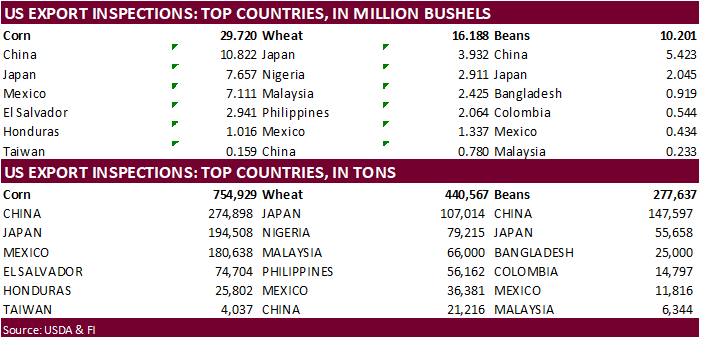
GRAINS
INSPECTED AND/OR WEIGHED FOR EXPORT
REPORTED IN WEEK ENDING AUG 12, 2021
— METRIC TONS —
—————————————————————————
CURRENT PREVIOUS
———–
WEEK ENDING ———- MARKET YEAR MARKET YEAR
GRAIN 08/12/2021 08/05/2021 08/13/2020 TO DATE TO DATE
BARLEY
866 1,297 1,996 6,377 2,461
CORN
754,929 744,934 1,139,132 64,350,092 40,579,955
FLAXSEED
0 0 0 24 317
MIXED
0 0 0 48 0
OATS
0 0 0 100 800
RYE
0 0 0 0 0
SORGHUM
55,165 75,837 87,240 6,898,032 4,731,435
SOYBEANS
277,637 114,718 932,541 58,661,647 41,190,721
SUNFLOWER
0 0 0 240 0
WHEAT
440,567 653,969 495,513 4,885,643 5,663,073
Total
1,529,164 1,590,755 2,656,422 134,802,203 92,168,762
————————————————————————
CROP
MARKETING YEARS BEGIN JUNE 1 FOR WHEAT, RYE, OATS, BARLEY AND
FLAXSEED;
SEPTEMBER 1 FOR CORN, SORGHUM, SOYBEANS AND SUNFLOWER SEEDS.
INCLUDES
WATERWAY SHIPMENTS TO CANADA.
Canadian
Manufacturing Sales (M/M) Jun: 2.1% (est 2.4%; prev -0.6%)
Canadian
Wholesale Trade Sales (M/M) Jun: -0.8% (est -2.0%; prev 0.5%)
OPEC+
Sees No Need To Release More Oil Into Mkt At The Moment ‘Beyond What Is Already Planned’ Despite US Calls – RTRS Citing OPEC+ Sources
70
Counterparties Take $1036.418 Bln At Fed’s Fixed-Rate Reverse Repo (prev $1050.94 Bln, 70 Bidders)
- US
corn ended
lower in the nearby contracts on follow through selling and lack of fresh US export developments. Technical selling was noted. Good amount of option flow occurred on the close. CZ 700c lifted 10,000x paid 4.5-5.0 in the last 2 minutes.
- USDA
reported US corn crop conditions dropped 2 points to 62 percent. The trade was looking for unchanged.

- Recall
last week’s FSA numbers indicated the US corn planted area could be revised up more than 1 million acres later this season. We raised our working planted estimate for the US corn area by 850,000 acres above USDA to 93.54 million, and harvested area by 722,000
acres to 85.22 million. - US
weather appears to be non-threatening for the majority of the Corn Belt, with cooler and drier conditions this week, bias east. Excessive heat is expected across the Great Plains and eastern Canada today before turning windy Tuesday into Wednesday.
- Tropical
storm Fred will hit the Florida Panhandle today. Rain from this storm is expected to reach into the upper Delta and blanket the SE this week.
- USDA
US corn export inspections as of August 12, 2021 were 754,929 tons, within a range of trade expectations, above 744,934 tons previous week and compares to 1,139,132 tons year ago. Major countries included China for 274,898 tons, Japan for 194,508 tons, and
Mexico for 180,638 tons. - AgRural
reported Brazilian corn harvesting across the center-south at 70% of their second corn, behind 77% year ago. Mato Grosso farmers is finished.
Export
developments.
- Qatar
seeks about 100,000 tons of barley on August 18 for Sep-Nov delivery.
- Turkey
seeks 270,000 tons of barley on August 20 for shipment between Sep 1 and Sep 25.
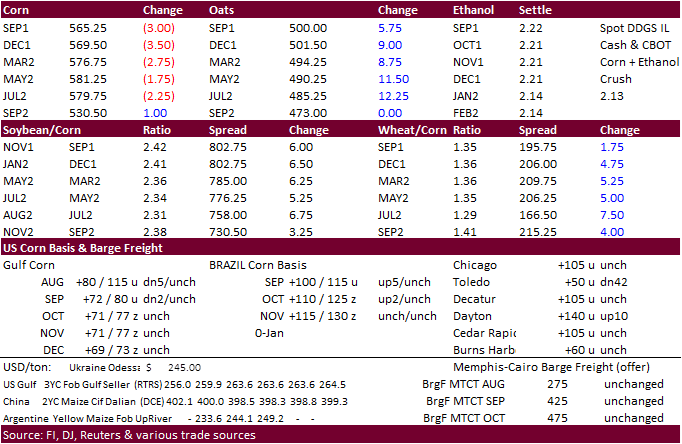
September
corn is seen is a $5.40-$6.00 range.
December
corn is seen in a $4.75-$6.00 range
-
Soybeans
and meal were higher while soybean oil saw selling from lower energies and a bearish NOPA stocks figure. USDA announced 132,000 tons of soybeans sold to unknow. Canadian canola crop concerns supported canola futures.
- USDA
reported soybean crop conditions dropped 3 points to 57 percent. The trade was looking for unchanged.

-
Pro
Farmer crop tour started today. Ohio and South Dakota averages should be out later this afternoon. Twitter feed #PFCropTour21
-
USDA
announced private exporters sold 132,000 tons of soybeans to unknown destinations for 2021-22 delivery.
-
USDA
US soybean export inspections as of August 12, 2021 were 277,637 tons, within a range of trade expectations, above 114,718 tons previous week and compares to 932,541 tons year ago. Major countries included China for 147,597 tons, Japan for 55,658 tons, and
Bangladesh for 25,000 tons. -
Argentina
was on holiday today. -
The
USDA announced they plan to raise the average US food stamp benefits by about 25% from pre-pandemic levels.
-
Cargo
surveyor SGS reported month to date August 15 Malaysian palm exports at 577,972 tons, 104,454 tons below the same period a month ago or down 15.3%, and 86,420 tons below the same period a year ago or down 13.0%.
AmSpec
reported Malaysian palm exports for the 1-15 period down 21% to 540,853 tons from 684,615 tons shipped during the same period last month. ITS reported a 24% decline to 528,736 tons.
-
Indian
vegetable oil imports during July fell 23% to 917,336 tons from June and were nearly down 40 percent from July 2020 when they imported 1.517 million tons. July palm imports were 465,600 tons, down from 587,500 tons.
NOPA
reported a July crush of 155.1 million bushels, 4 million below a trade average, and lowest for the month since 2017. Daily adjusted the crush fell to its lowest level since September. Despite the 0.8 million/day decline in the daily July crush from the
previous month, the large soybean oil stocks surprised the trade as they increased to 1.617 billion pounds from 1.537 billion at the end of June. Implied US soybean use for the month of July is lowest since December 2019. The soybean oil yield increased
to 11.83 from 11.80 pounds per bushel from the previous month. Soybean meal exports were 720,000 short tons, up from 715,000 previous month and compares to 876,000 short tons during July 2020. US cumulative September through July crush of 1.862 billion bushels
is running 0.6% below the same period year earlier. My guess soybean oil stocks were so large was the fact the last couple EIA biofuel reports indicated less than expected SBO use, along with very high yields for production.

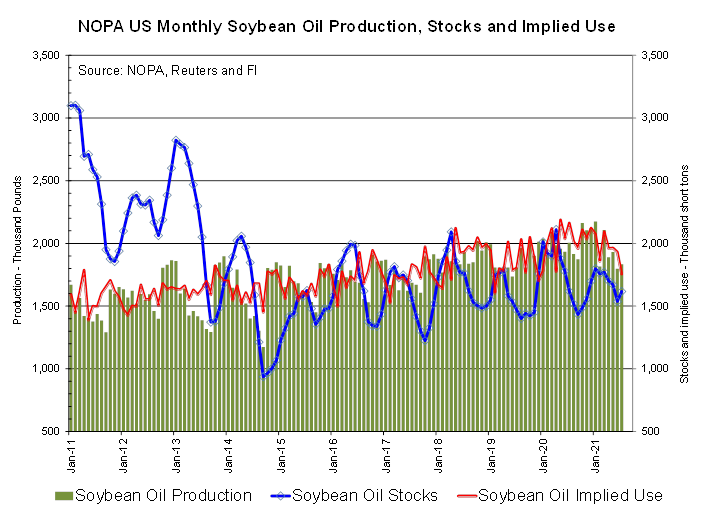
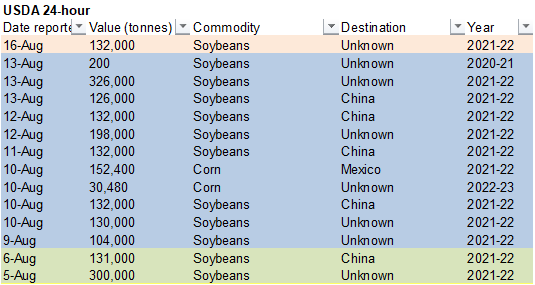
Export
Developments
- USDA
On August 17 seeks 290,000 tons of veg oil for use in export programs. 210 tons in 4-liter cans and 80 tons in 4-liter cans or plastic bottles, for shipment Sep16 to Oct 15 (Oct 1-31 for plants at ports).
- South
Korea’s Agro-Fisheries & Food Trade Corp. seeks 3,700 tons of non-GMO soybeans on August 19 for arrival between Oct. 20 and Nov. 19.
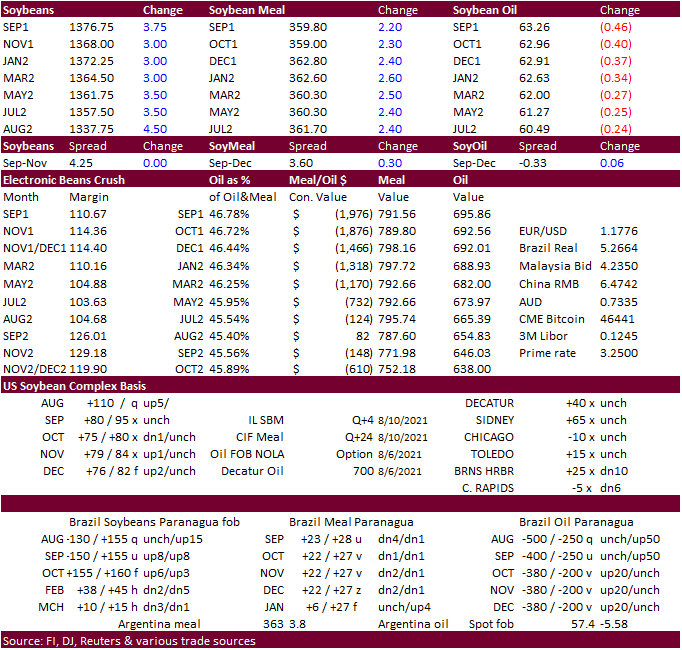
Updated
8/12/21
September
soybeans are seen in a $12.75-$14.50 range; November $11.75-$15.00
September
soybean meal – $335-$370; December $320-$425
September
soybean oil – 60.00-65.00; December 48-67 cent range
- US
wheat traded two-sided, with Chicago mostly higher, KC lower, and MN down in the front month contracts. Ongoing good global demand (Algeria and Philippines) for wheat and (Jordan and North Cyprus) for barley, and concerns over the French wheat & Russian
wheat crops underpinned prices, but in the end technical selling was a factor in today’s trade. Paris December wheat ended down 2.25 at 251.50 euros. The contract failed to test a contract high today.
-
USDA
reported US spring wheat crop conditions unchanged at 11 percent, as expected. Spring wheat harvest advanced 20 points to 58 percent, one point above expectations.
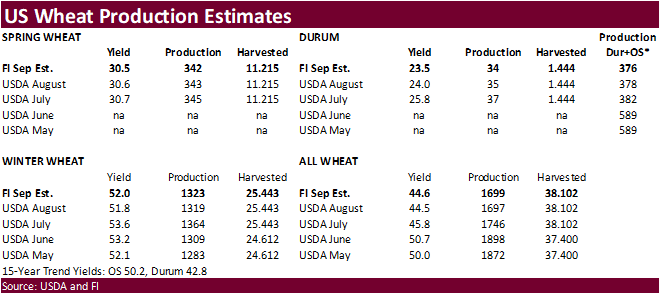
-
USDA
US all-wheat export inspections as of August 12, 2021 were 440,567 tons, within a range of trade expectations, below 653,969 tons previous week and compares to 495,513 tons year ago. Major countries included Japan for 107,014 tons, Nigeria for 79,215 tons,
and Malaysia for 66,000 tons. - FranceAgriMer
warned the recent rains across France likely negatively impacted crop conditions for soft wheat. Uneven test weights were noted.
- SovEcon
lowered their Russian wheat crop estimate by 200,000 tons to 76.2 million. USDA is at 72.50 million tons.
- Russian
wheat cash prices rose $20/ton to $287/ton fob at the end of last week, according to IKAR. SovEcon reported at $18/ton increase from the previous week to $286/ton.
- North
Cyprus bought 30,000 tons of feed barley for Aug 15-31 shipment (282.80/ton c&f), Sep 1-15 shipment ($298.50/ton c&f) and Sep 15-30 shipment $293.50/ton c&f.
- Algeria
seeks an unspecified amount of wheat on Tuesday for September shipment. - The
Philippines seeks 280,000 tons of feed wheat on August 19 for October/November shipment.
- Jordan
seeks 120,000 tons of feed barley on August 19. - Japan
(SBS) seeks 80,000 tons of feed wheat and 100,000 tons of feed barley on August 18 for loading by November 30.
- Bangladesh
seeks 50,000 tons of wheat on August 18. - Pakistan
seeks 400,000 tons of wheat on August 23 for Sep/Oct shipment. - Morocco
seeks 363,000 tons of US durum wheat under a tariff import quota on August 24 for shipment by December 31.
Rice/Other
-
None
reported
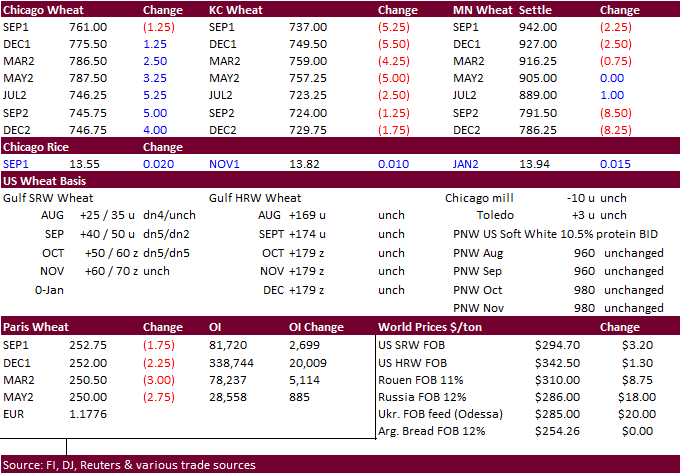
Updated 8/13/21
September Chicago wheat is seen in a $6.75‐$8.00 range
September KC wheat is seen in a $6.50‐$7.70
September MN wheat is seen in a $8.50‐$9.75
Terry Reilly
Senior Commodity Analyst – Grain and Oilseeds
Futures International
One Lincoln Center
18 W 140 Butterfield Rd.
Oakbrook Terrace, Il. 60181
W: 312.604.1366
ICE IM:
treilly1
Skype: fi.treilly

Trading of futures, options, swaps and other derivatives is risky and is not suitable for all persons. All of these investment products are leveraged, and you can lose more than your initial deposit. Each investment product is offered
only to and from jurisdictions where solicitation and sale are lawful, and in accordance with applicable laws and regulations in such jurisdiction. The information provided here should not be relied upon as a substitute for independent research before making
your investment decisions. Futures International, LLC is merely providing this information for your general information and the information does not take into account any particular individual’s investment objectives, financial situation, or needs. All investors
should obtain advice based on their unique situation before making any investment decision. The contents of this communication and any attachments are for informational purposes only and under no circumstances should they be construed as an offer to buy or
sell, or a solicitation to buy or sell any future, option, swap or other derivative. The sources for the information and any opinions in this communication are believed to be reliable, but Futures International, LLC does not warrant or guarantee the accuracy
of such information or opinions. Futures International, LLC and its principals and employees may take positions different from any positions described in this communication. Past results are not necessarily indicative of future results.

